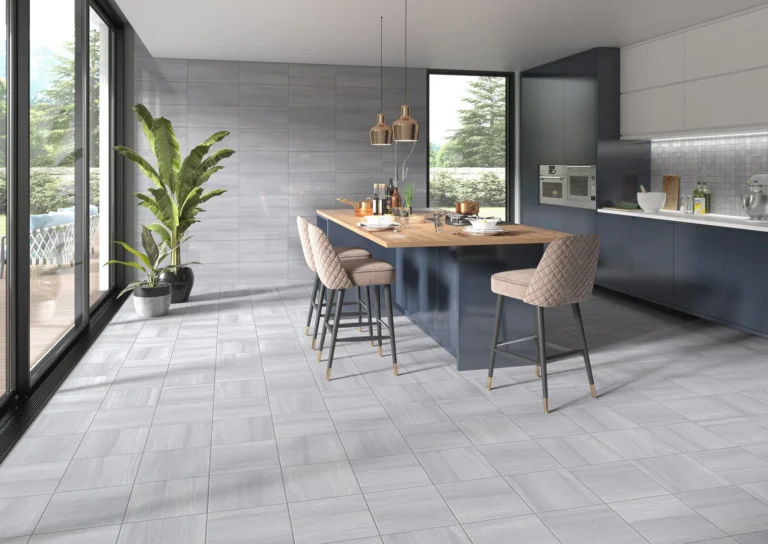
Top Factors to Consider Before Choosing Kitchen Flooring
Water Resistance and Spills
Kitchens are high-moisture zones prone to splashes, spills, and the occasional dropped pan of pasta water. Choose a flooring option that can handle water exposure without warping, staining, or becoming slippery. Waterproof or water-resistant materials like luxury vinyl, tile, and certain types of engineered hardwood are ideal for kitchens.
Durability for Heavy Foot Traffic
Your kitchen likely sees more foot traffic than any other room in the house. From busy morning routines to dinner prep, your floors need to hold up under constant movement, dropped utensils, and the wear of shoes. Look for high-durability ratings and materials that resist dents, scratches, and surface wear.
Comfort Underfoot
If you spend a lot of time cooking, standing comfort matters. Some flooring materials—like cork or vinyl—offer a bit more cushioning than harder surfaces like tile. You can also factor in the use of anti-fatigue mats or underlayment for added softness and insulation.
Ease of Cleaning and Maintenance
The kitchen is where spills and messes happen daily. Prioritize flooring that’s easy to wipe down, mop, or sweep. Non-porous surfaces that resist stains—like tile, sealed hardwood, or vinyl—make cleanup quick and painless.
Visual Style and Design Cohesion
Your kitchen floor plays a big role in the room’s overall look. Consider how the flooring color, tone, and texture will pair with your cabinets, countertops, and backsplash. Whether you want warm wood tones, sleek stone finishes, or modern patterned tiles, make sure the flooring ties your space together seamlessly.
Kitchen Flooring Factors Comparison Chart
| Material | Water Resistance | Durability | Comfort | Maintenance | Style Compatibility |
|---|---|---|---|---|---|
| Luxury Vinyl Plank (LVP) | ✅ Waterproof | ✅ High | ✅ Soft | ✅ Easy | ✅ Versatile |
| Porcelain Tile | ✅ Waterproof | ✅ High | ❌ Hard | ✅ Easy | ✅ Modern/Classic |
| Ceramic Tile | ✅ Water-Resistant | ✅ High | ❌ Hard | ✅ Easy | ✅ Traditional |
| Hardwood | ❌ Not Ideal | ✅ High | ✅ Warm | ❌ Moderate | ✅ Timeless |
| Engineered Wood | ⚠️ Water-Resistant | ✅ Moderate | ✅ Warm | ⚠️ Moderate | ✅ Contemporary |
| Laminate | ⚠️ Water-Resistant | ✅ Moderate | ⚠️ Moderate | ✅ Easy | ✅ Modern |
| Sheet Vinyl | ✅ Waterproof | ✅ Moderate | ✅ Soft | ✅ Easy | ✅ Varied |
| Cork | ⚠️ Water-Resistant | ⚠️ Moderate | ✅ Cushioned | ⚠️ Moderate | ✅ Eco-Friendly |
| Concrete | ✅ Waterproof | ✅ High | ❌ Hard | ✅ Easy | ✅ Industrial |
| Natural Stone | ⚠️ Water-Resistant | ✅ High | ❌ Hard | ❌ High | ✅ Luxurious |
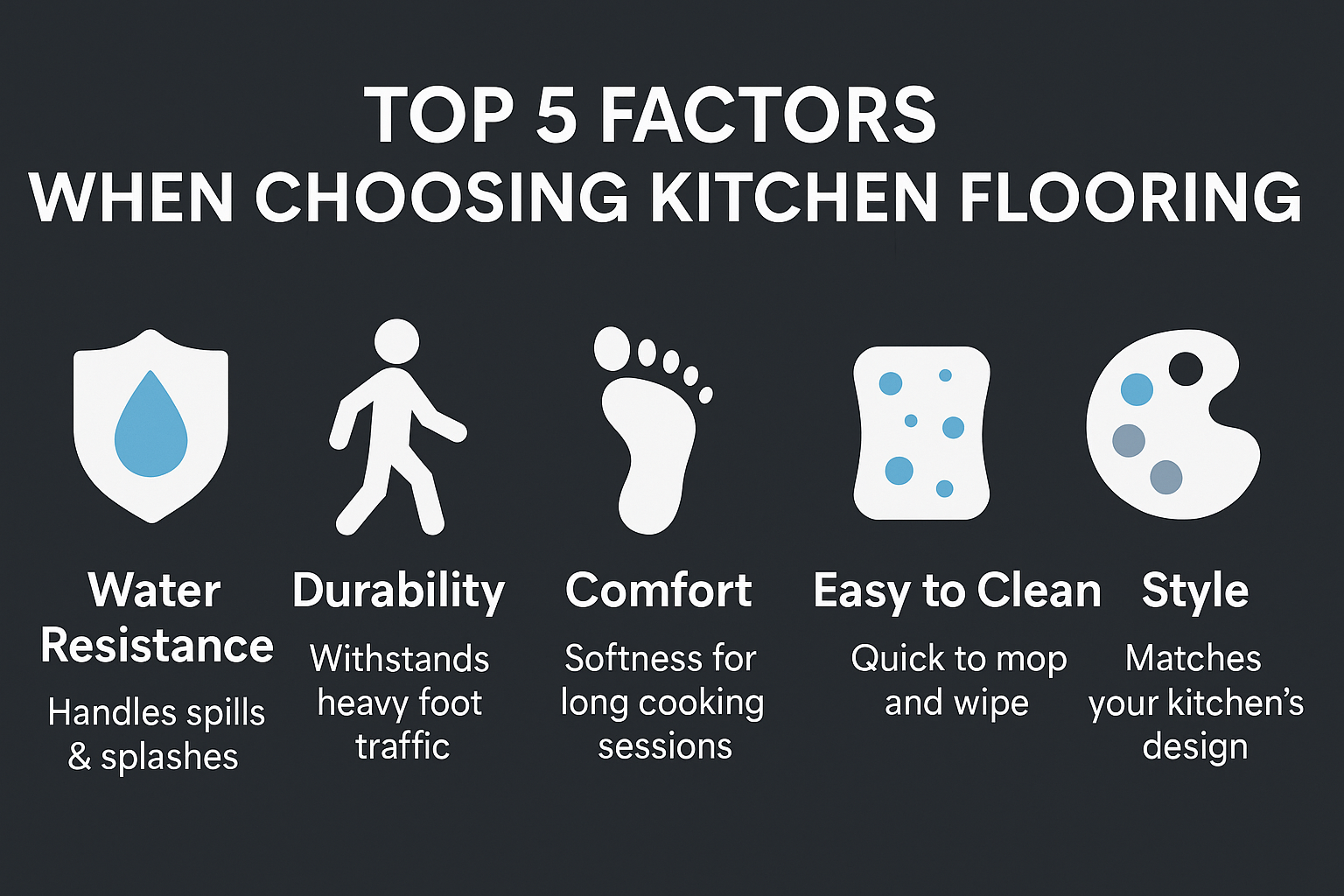
Best Kitchen Flooring Materials (Pros & Cons)
Choosing the right kitchen flooring means balancing style, performance, and practicality. Here’s a breakdown of the most popular kitchen flooring options in 2025 — complete with their real-world advantages and limitations:
Hardwood Flooring in the Kitchen
Pros: Brings timeless warmth and natural character to any kitchen space, enhancing resale value.
Cons: Hardwood flooring in the kitchen is prone to moisture damage and can warp without proper sealing.
Luxury Vinyl Plank (LVP) in the Kitchen
Pros: A top choice for kitchen flooring, LVP is waterproof, affordable, and offers realistic wood and stone visuals with cushioned comfort.
Cons: Lower-quality LVP in the kitchen may dent or discolor under heavy use or sunlight.
Tile Flooring in the Kitchen (Ceramic & Porcelain)
Pros: Tile is a classic kitchen flooring solution — durable, water-resistant, and available in a range of finishes and colors.
Cons: Tile in the kitchen can feel cold and hard underfoot, often requiring area rugs or underfloor heating for added comfort.
Laminate Flooring in the Kitchen
Pros: Laminate provides a cost-effective kitchen flooring option with modern styles and water-resistant versions that are easy to clean.
Cons: Traditional laminate in the kitchen can be vulnerable to standing water and may not match the lifespan of tile or vinyl.
Natural Stone Flooring in the Kitchen
Pros: Adds elegance and uniqueness to upscale kitchen flooring designs with incredible durability.
Cons: Stone floors in the kitchen require sealing, are expensive, and can be slippery or cold without rugs.
Sheet Vinyl Flooring in the Kitchen
Pros: A practical kitchen flooring choice, sheet vinyl offers a seamless, waterproof barrier and soft, quiet feel underfoot.
Cons: Sheet vinyl in the kitchen may lack the realism of LVP and can wear down in high-traffic zones over time.
Engineered Wood in the Kitchen
Pros: A stylish alternative to solid hardwood, engineered wood flooring in the kitchen resists moisture better and looks just as warm.
Cons: It’s still susceptible to water damage, and the price is higher than vinyl or laminate kitchen flooring options.
Cork Flooring in the Kitchen
Pros: Cork creates a soft, eco-friendly kitchen flooring surface that reduces noise and fatigue during long cooking sessions.
Cons: Cork in the kitchen must be sealed regularly to prevent moisture damage and may fade in direct sunlight.
Concrete Flooring in the Kitchen
Pros: Delivers an industrial-modern vibe for contemporary kitchen flooring with unbeatable durability and waterproof qualities.
Cons: Concrete floors in the kitchen can feel uncomfortably hard or cold without radiant heating or area rugs.
| # | Material | Pros (Kitchen Use) | Cons (Kitchen Use) |
|---|---|---|---|
| 1 | Luxury Vinyl Plank (LVP) | Fully waterproof, realistic visuals, affordable, soft underfoot | Lower-end versions may dent or fade in busy kitchens |
| 2 | Porcelain/Ceramic Tile | Water-resistant, extremely durable, perfect for high-moisture kitchen zones | Cold and hard underfoot — may need rugs or radiant heating |
| 3 | Sheet Vinyl | Seamless waterproof surface, soft, quiet, and very budget-friendly | Less realistic texture; not as durable over time in high-traffic kitchens |
| 4 | Engineered Wood | More moisture-tolerant than hardwood, brings natural warmth to the kitchen | Still vulnerable to prolonged water exposure |
| 5 | Laminate Flooring | Affordable kitchen upgrade with water-resistant designs available | May swell or delaminate if water seeps into seams |
| 6 | Concrete | Extremely durable and waterproof when sealed, ideal for industrial kitchen styles | Cold and hard underfoot; may require sealing and heating |
| 7 | Cork | Cushioned, quiet, eco-conscious choice for kitchens with lots of standing | Needs sealing and UV protection to prevent damage |
| 8 | Natural Stone | Elegant and upscale, with excellent durability | Expensive, requires ongoing sealing, and can be slippery when wet |
| 9 | Hardwood Flooring | Timeless, warm aesthetic for open-plan kitchens | Not suitable for heavy moisture without significant maintenance |
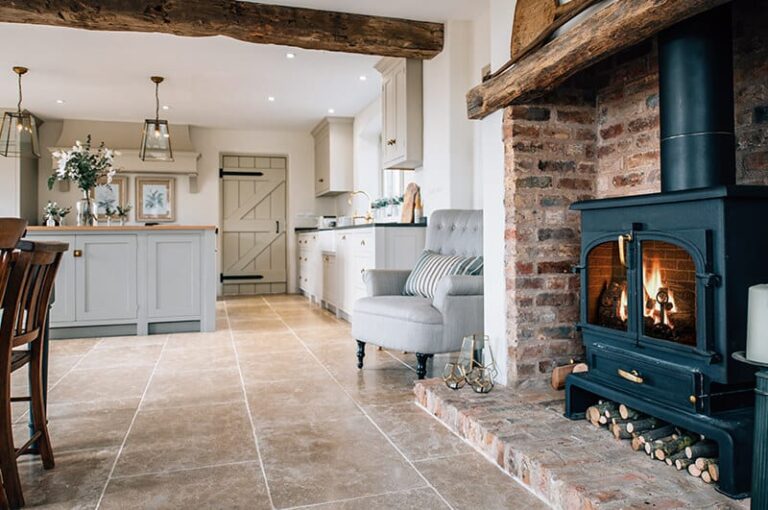
Waterproof vs. Water-Resistant: What You Really Need For Your Kitchen Floors
When choosing kitchen flooring, one of the most important considerations is how well the material handles water. But not all water-safe floors are created equal — and the terms “waterproof” and “water-resistant” are often confused.
🔍 Key Differences Explained
- Waterproof kitchen flooring means the material is completely impervious to water — it can be soaked, submerged, or steam-cleaned without warping, staining, or damage.
- Water-resistant kitchen flooring can handle minor spills and damp mops but may absorb water if it’s left standing or seeps into seams and edges over time.
Think of waterproof as your raincoat, and water-resistant as your hoodie — both provide protection, but one holds up far better in a downpour.
💧 Which Flooring Materials Are Truly Waterproof?
If your kitchen is prone to spills, heavy cleaning, or even the occasional dishwasher leak, these waterproof kitchen flooring materials offer the best defense:
- Luxury Vinyl Plank (LVP) and Sheet Vinyl – Fully waterproof and ideal for families, renters, and busy kitchens.
- Porcelain and Ceramic Tile – Waterproof when installed with proper grout and sealing.
- Concrete Flooring – 100% waterproof once sealed; great for modern, industrial kitchens.
🏡 Best Flooring for High-Moisture Kitchens
In homes with kids, pets, or lots of cooking activity, these kitchen flooring materials strike the best balance of waterproofing, comfort, and durability:
- Luxury Vinyl Plank (LVP) – Top pick for waterproof performance and style.
- Sheet Vinyl – Great for seamless protection at a lower cost.
- Tile (Porcelain or Ceramic) – Extremely durable and waterproof when installed correctly.
- Engineered Wood with Water-Resistant Core – For homeowners who want real wood aesthetics with moderate water protection.
Avoid using solid hardwood or unsealed cork in high-moisture kitchens unless you’re committed to constant upkeep and sealing.
Easy-to-Clean Kitchen Flooring Options
A clean kitchen isn’t just about hygiene — it’s about choosing kitchen flooring that hides messes and makes your life easier. Whether you’re dealing with crumbs, spills, or everyday foot traffic, some materials perform better than others when it comes to low-maintenance upkeep.
🧼 Top Kitchen Flooring Materials for Stain Resistance
- Porcelain and Ceramic Tile – Naturally stain-resistant and easy to wipe down, even after grease splatters or tomato sauce mishaps.
- Luxury Vinyl Plank (LVP) – The protective top layer resists stains, scuffs, and grime — ideal for high-traffic kitchen zones.
- Sheet Vinyl – Its seamless surface prevents spills from seeping in and makes for super quick cleaning.
- Sealed Concrete – Highly resistant to stains if properly sealed; perfect for modern kitchens with bold aesthetics.
👀 Finishes That Hide Dirt and Crumbs
Not all kitchen flooring shows mess the same way. These finishes are great at disguising daily debris:
- Matte Finishes – Reduce glare and hide smudges and dust better than glossy surfaces.
- Textured Surfaces – Subtle wood grains or stone textures help conceal crumbs and footprints.
- Mid-Tone Neutrals – Beige, taupe, or greige tones are the sweet spot between too-dark and too-light, hiding both dirt and pet hair.
✨ Maintaining Shine and Durability
To keep your kitchen floor looking as good as it functions:
- Sweep or vacuum regularly to remove grit that can scratch the surface.
- Use a damp mop with manufacturer-approved cleaners — avoid harsh chemicals on vinyl, laminate, or sealed wood.
- Reapply sealant for materials like concrete, cork, or natural stone every few years to protect against stains and moisture.
- Add felt pads to the bottom of kitchen chairs and stools to reduce wear and tear over time.
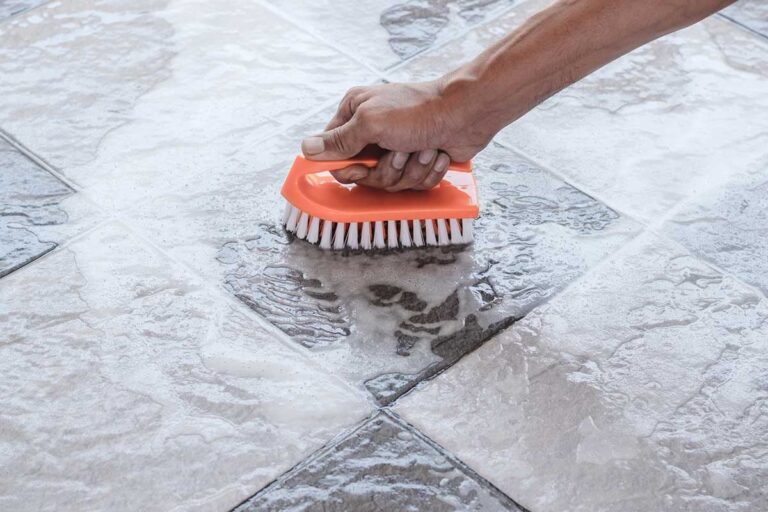
Cost Breakdown Of Kitchen Flooring By Material & Labor
Your choice of kitchen flooring has a big impact on your overall renovation budget — but with the right info, you can balance cost, performance, and longevity. Here’s what you need to know about pricing, installation options, and long-term value.
💰 Material Cost Per Square Foot (2025 Averages)
| Material | Price (Per Sq Ft) |
|---|---|
| Sheet Vinyl | $1 – $3 |
| Laminate Flooring | $1.50 – $4 |
| Luxury Vinyl Plank | $2 – $5 |
| Ceramic Tile | $2 – $6 |
| Engineered Wood | $4 – $8 |
| Porcelain Tile | $3 – $10 |
| Concrete (Polished) | $3 – $12 |
| Cork Flooring | $4 – $7 |
| Hardwood Flooring | $6 – $12 |
| Natural Stone | $7 – $20+ |
These prices reflect mid-range quality products. Premium designs, added underlayment, or special finishes can raise the total cost. Want a detailed cost breakdown for each material?
- Laminate Flooring Cost Guide
- Vinyl Flooring Cost Guide
- Hardwood Flooring Cost Guide
- Tile Flooring Cost Guide
- Carpet Flooring Cost Guide
🛠️ Installation Cost: DIY vs. Professional
| Material | DIY-Friendly? | Professional Install Cost (Per Sq Ft) |
|---|---|---|
| Sheet Vinyl | ✅ Very Easy | $1 – $3 |
| Laminate | ✅ Easy | $2 – $5 |
| Luxury Vinyl Plank | ✅ Easy | $2 – $6 |
| Ceramic/Porcelain Tile | ❌ Moderate-Hard | $5 – $15 |
| Engineered Wood | ⚠️ Moderate | $4 – $10 |
| Hardwood | ❌ Difficult | $6 – $15 |
| Concrete | ❌ Specialized | $5 – $12 |
| Cork | ⚠️ Moderate | $4 – $8 |
| Natural Stone | ❌ Complex | $8 – $20+ |
DIY can save significantly on labor, but complex materials like tile, stone, and hardwood are best left to flooring installation professionals unless you have advanced experience. Thinking of installing it yourself? We’ve got full DIY flooring guides for each major type:
- How To Install Laminate Flooring (DIY Guide)
- How To Install Vinyl Flooring (DIY Guide)
- How To Install Tile Flooring (DIY Guide)
- How To Install Hardwood Flooring (DIY Guide)
- How To Install Carpet Flooring (DIY Guide)
📈 Longevity & Value Over Time
- Best Value Long-Term: Porcelain Tile, Luxury Vinyl Plank, and Engineered Wood — excellent balance of durability and style.
- Budget-Friendly with Good Lifespan: Laminate and Sheet Vinyl — easy to install and maintain, though shorter lifespan (~10–15 years).
- Premium Investment: Natural Stone and Hardwood Flooring — high upfront cost, but excellent durability and home value boost if maintained.
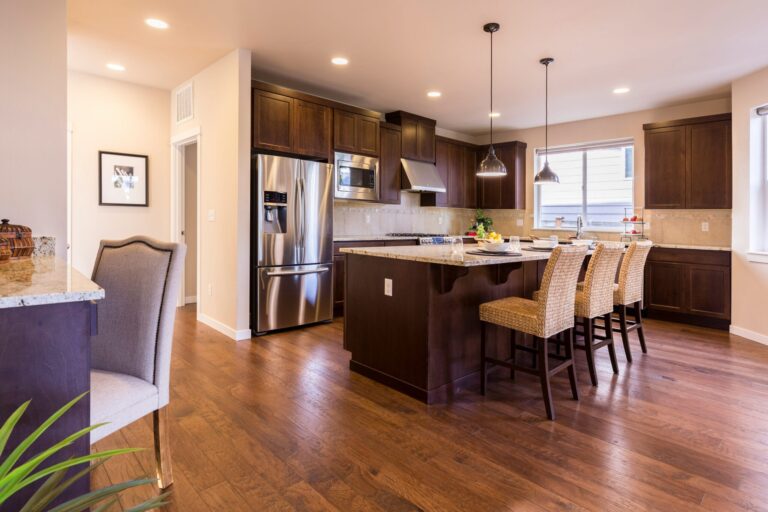
Eco-Friendly Kitchen Flooring Options
If you’re designing a healthier home or aiming to reduce your environmental footprint, choosing the right eco-friendly kitchen flooring can make a big impact. The good news? Sustainable materials have come a long way — they’re now stylish, durable, and better for your indoor air quality.
🌱 Top Eco-Friendly Kitchen Flooring Materials
- Cork Flooring – Made from the renewable bark of cork oak trees, cork is harvested without harming the tree. It’s naturally antimicrobial, cushioned underfoot, and a great choice for energy-efficient kitchens thanks to its insulating properties.
- Bamboo Flooring – A fast-growing grass (not a wood!), bamboo is highly renewable and offers a sleek, modern kitchen flooring look. Strand-woven bamboo is the most durable option for busy homes.
- Reclaimed Hardwood – Gives existing materials a second life, reducing demand for newly harvested trees. Each plank tells a story, offering rustic character and one-of-a-kind charm — ideal for farmhouse or vintage-style kitchens.
🏡 VOC Ratings and Healthy Home Considerations
Not all “natural” floors are safe for indoor air. Look for low-VOC or zero-VOC certified flooring to avoid off-gassing of harmful chemicals:
- Check for certifications like FloorScore, Greenguard GOLD, or CARB Phase 2 compliance.
- Choose water-based finishes and adhesives.
- Avoid vinyl or laminate products that use high levels of formaldehyde or phthalates — unless specifically labeled low-emission.
Eco-friendly flooring in the kitchen isn’t just about materials — it’s also about protecting your family’s health and indoor air quality.
15 Kitchen Flooring Ideas for 2025
- Wide Plank Hardwood Flooring
Wide plank hardwood floors, such as oak or maple, bring a sense of openness and continuity to kitchen spaces. Their expansive boards showcase natural wood grains, adding warmth and elegance. Explore our Hardwood Flooring options

- Herringbone Pattern in Luxury Vinyl Plank
Herringbone patterns in luxury vinyl planks offer a classic design with modern durability. This style adds visual interest and sophistication to kitchens while being resistant to moisture and wear. Discover our Luxury Vinyl Plank selections

- Matte Finish Porcelain Tiles
Matte finish porcelain tiles provide a sleek, contemporary look that minimizes glare and hides smudges, making them ideal for busy kitchens. Browse our Porcelain Tile collection
- Seamless Indoor-Outdoor Transitions
Using consistent flooring materials, like porcelain tiles, from the kitchen to adjacent outdoor areas creates a harmonious flow, perfect for entertaining and open-plan living. View our Laminate Flooring options

- Natural Stone-Look Porcelain Tiles
Porcelain tiles that mimic natural stone offer the luxurious appearance of materials like marble or slate with enhanced durability and lower maintenance. Explore our Porcelain Tile selections

- Large Format Tiles
Large format tiles reduce grout lines, resulting in a seamless and expansive look that enhances the kitchen’s spaciousness. Check out our Ceramic Tile collection

- Wood-Look Porcelain Tiles
Combining the warmth of wood aesthetics with the durability of porcelain, these tiles are resistant to moisture and wear, making them suitable for high-traffic kitchen areas. Discover our Porcelain Tile options
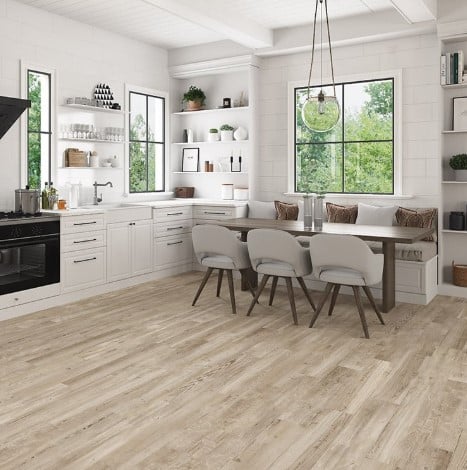
- Patterned & Decorative Tiles
Incorporating bold patterns, such as geometric or Moroccan designs, adds personality and a focal point to the kitchen floor. Browse our Porcelain Tile collection

- Sustainable Materials
Eco-friendly options like bamboo, cork, and reclaimed wood support sustainability while maintaining style. Explore our Hardwood Flooring selections

- Textured Finishes
Floors with tactile surfaces, such as hand-scraped wood or embossed tiles, add depth and character, enhancing the sensory experience of the kitchen environment. Discover our Hardwood Flooring options

- Neutral & Earthy Tones
Colors like beige, taupe, and soft greys are trending, providing a versatile backdrop that complements various kitchen styles and color schemes. View our Porcelain Tile collection
- Mixed Material Designs
Combining different flooring materials, such as wood and tile, allows for creative zoning within open-plan kitchens, delineating areas like cooking and dining spaces. Explore our Hardwood Flooring selections
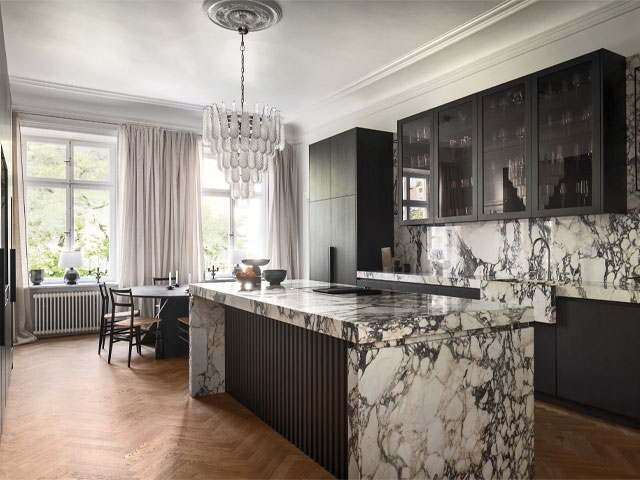
- Checkerboard Patterns
Classic black-and-white checkerboard floors make a comeback, providing a timeless and playful design element. Browse our Porcelain Tile collection
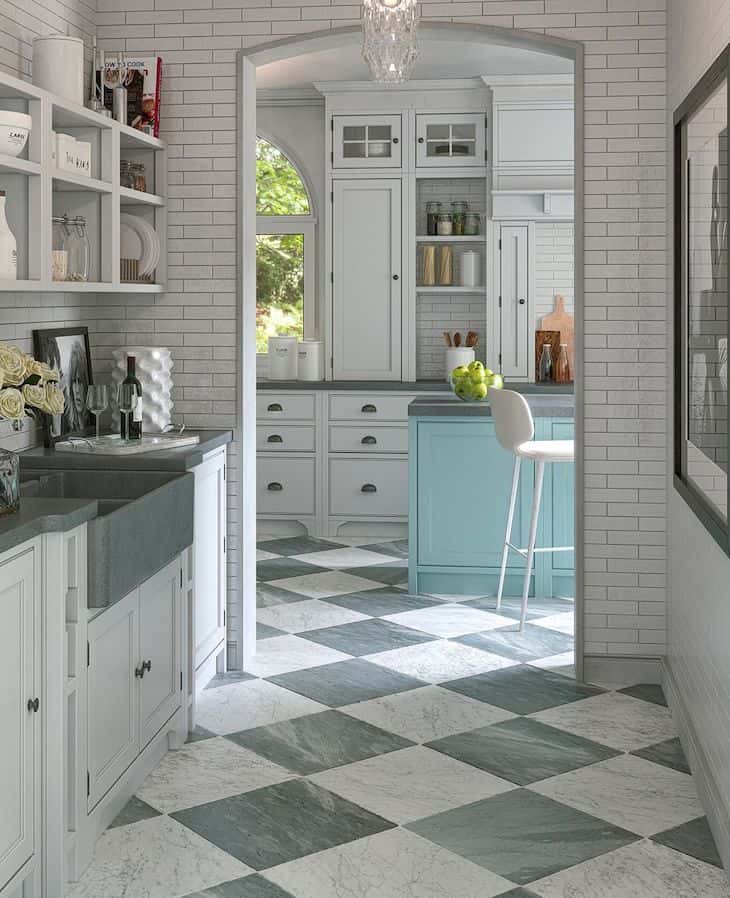
- Terra-Cotta Tiles
Embracing the warmth of terra-cotta tiles brings a rustic charm and earthy tone to the kitchen environment. Discover our Porcelain Tile options

- Engineered Hardwood Flooring
Engineered hardwood offers the beauty of natural wood with added stability and resistance to moisture, making it suitable for kitchen environments. Explore our Engineered Hardwood Flooring selection
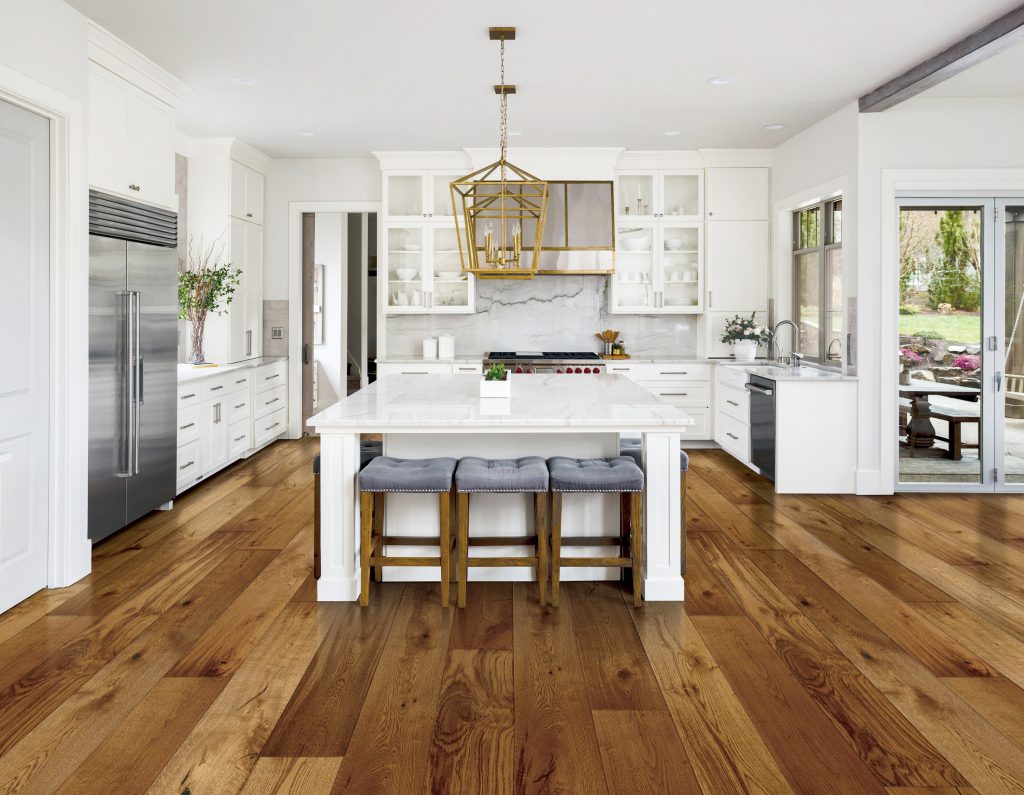
Final Tips Before You Buy Kitchen Flooring
Before making your final decision, it’s worth slowing down to double-check a few important steps. These small actions can save you time, money, and future headaches when choosing the perfect kitchen flooring.
📦 1. Order Extra Material for Cuts and Waste
Always purchase 10–15% more flooring than your kitchen’s actual square footage. This accounts for waste from cuts, mistakes, and future repairs. Running short mid-installation — especially with patterned tiles or discontinued stock — can delay your entire project.
💡 2. Test Flooring Samples in Your Kitchen Lighting
Flooring looks different in daylight, artificial light, and under-cabinet LEDs. What appears warm in the store might look too cool or dull in your space. Place samples on the floor and check them at different times of day to see how they interact with your kitchen’s colors and lighting.
🛡️ 3. Understand Manufacturer Warranties
Not all warranties are created equal. Read the fine print to understand:
- Whether it covers water damage, wear, fading, or installation issues.
- If professional installation is required to activate the warranty.
- What voids the warranty — like using unapproved cleaners or DIY installs on certain products.
🎯 Bonus Tip: Match Floor Choice to Lifestyle
- Busy family home? Go waterproof and low-maintenance (LVP, tile, or sheet vinyl).
- Design-focused kitchen? Explore trending styles like herringbone vinyl or natural stone-look tiles.
- Eco-conscious household? Prioritize cork, bamboo, or reclaimed wood with low-VOC certifications.
Do You Need Help Choosing or Installing Your Kitchen Flooring?
Now that you’ve explored the top kitchen flooring materials, costs, and design ideas, you’re one step closer to creating a beautiful and functional kitchen. But if you’d rather leave the measuring, prep, and installation to the pros, our expert team is ready to help.
We take care of everything — from subfloor inspection and moisture testing to precise installation of luxury vinyl plank, porcelain tile, engineered hardwood, laminate, and more.
We’ll also help you select the right kitchen flooring material based on your lifestyle, layout, and budget — whether you want waterproof durability, low-maintenance comfort, or on-trend design.
Click here to contact us today to schedule your free in-home consultation and find out if we serve your area!






